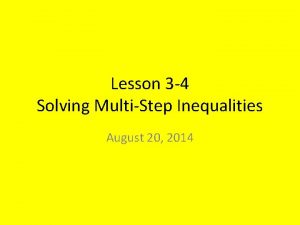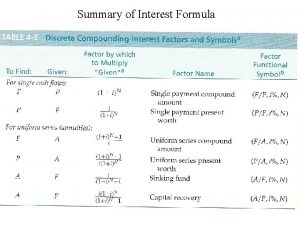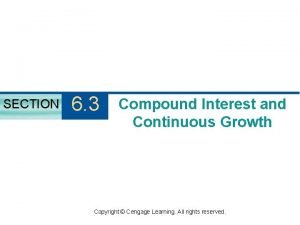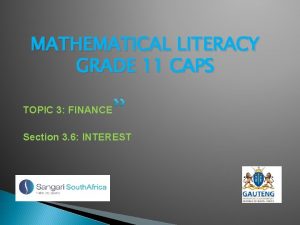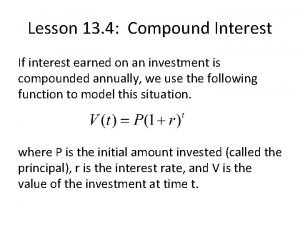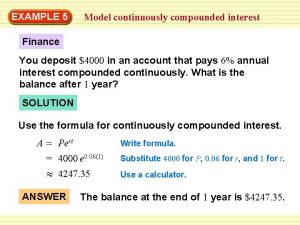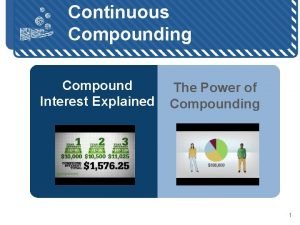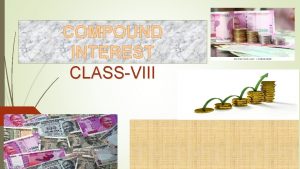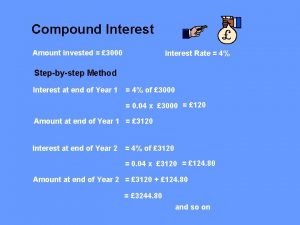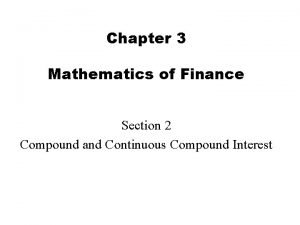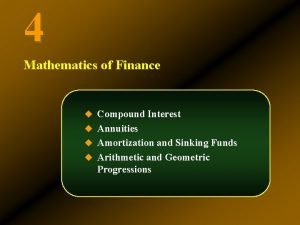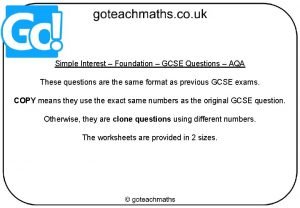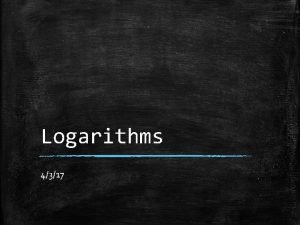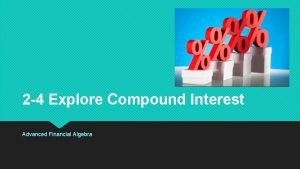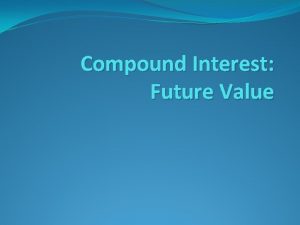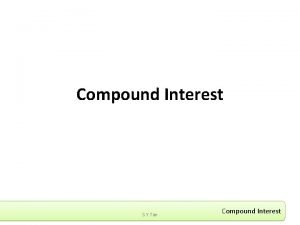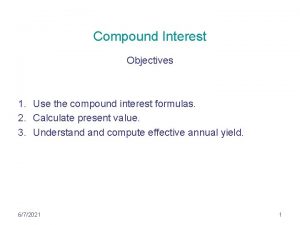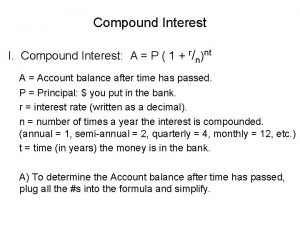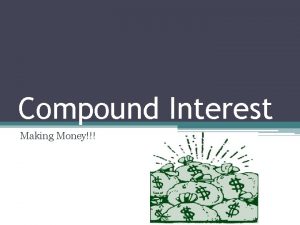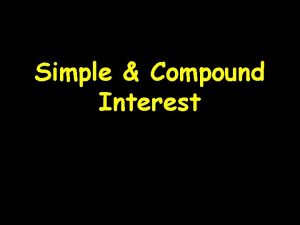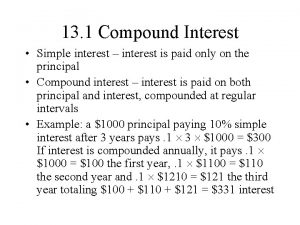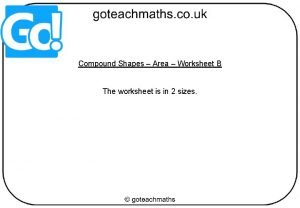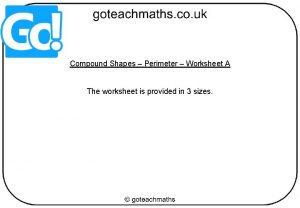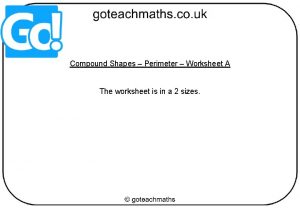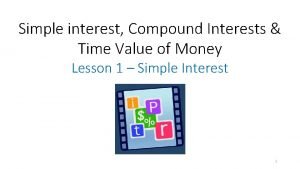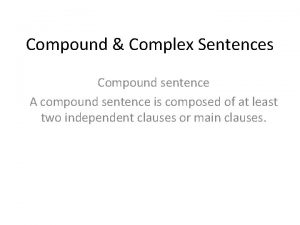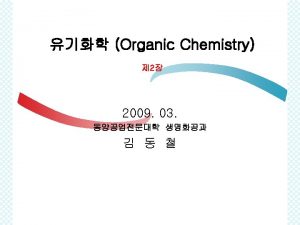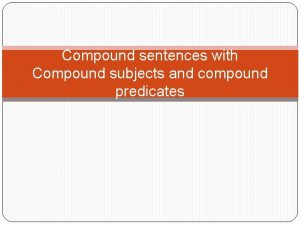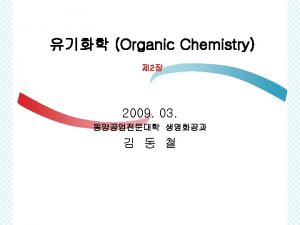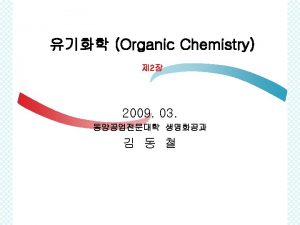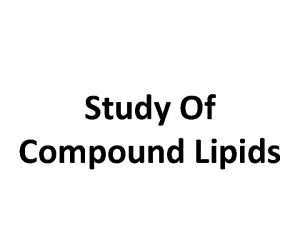Compound Interest homework Worksheet Compound Interests Does anyone



























- Slides: 27

Compound Interest

homework • Worksheet: Compound Interests

Does anyone have any interest in interest? Very few banks today pay interest based on the simple interest formula. Instead, they pay interest by using a principle called compounding. The difference between simple and compound interest is this: Simple interest grows slowly, compounding speeds up the process.

How it works. Simple interest is interest on the principle amount. Compound interest is when your principle and any earned interest both earn interest.

Consider this example: You begin with $100 invested at 10% annual interest. After 1 year 2 years 3 years 4 years 5 years 10 years 20 years 50 years Simple Interest 110 120 130 140 150 200 300 600 Compound Interest 110 121 133 146 161 259 672 11, 739

Compound Interest Wins!! From this example, it is easy to see that if you are saving money, you would prefer compound interest.

Convert Percent into Decimals • • 56. 35% 0. 034% 7. 8% 1%

P is the principal amount (starting amount) r is the annual interest rate m is the number of times interest is compounded per year t is the number of years

Calculate compound interest using this formula: A—Total amount p —principle r —interest rate n —number of compounding periods t —time in years

Compounding Period Annually m=1 Semiannually m=2 Quarterly m=4 Daily m=365



Example 2: Find the final amount of a $100 investment after 10 years at 5% interest compounded annually, quarterly, and daily. Compounding period Annually Quarterly Daily m Final amount


Example 3: Find the final amount of a $2000 certificate of deposit (CD) after 5 years at an annual interest rate of 5. 51% compounded annually? Compounding period m Final amount

Calculate compound interest using this formula: A—Total amount p —principle r —interest rate n —number of compounding periods t —time in years

Example: $100 is invested at 10% interest compounded yearly for 6 years 177. 16

$250 invested at 6. 5% for 8 years compounded monthly. 419. 92

Example…… • $500 invested at 12% for 10 years compounded yearly.

Answer…… • Problem: • $500 invested at 12% for 10 years compounded yearly. • Answer:

Example…… • $1000 at 7. 25% for 9 years compounded monthly.

Answer…… • Problem: • $1000 at 7. 25% for 9 years compounded monthly. • Answer:

Try these: 1. $750 at 6. 5% for 5 years compounded annually 2. $25, 000 at 8% for 3 years compounded annually 3. $680 at 5. 5% for 1. 5 years compounded monthly 4. $1500 at 4. 5% for 2 years compounded monthly

• Problem: • $750 at 6. 5% for 5 years compounded annually • Answer:

• Problem: • $25, 000 at 8% for 3 years compounded annually • Answer:

• Problem: 1. $680 at 5. 5% for 1. 5 years compounded monthly • Answer:

• Problem: • $1500 at 4. 5% for 2 years compounded monthly • Answer:
 Compound interest multiplier
Compound interest multiplier Simple and compound interest practice worksheet answer key
Simple and compound interest practice worksheet answer key Hobbies and interests meaning
Hobbies and interests meaning Homework oh homework
Homework oh homework Homework oh homework i hate you you stink
Homework oh homework i hate you you stink Jack prelutsky homework oh homework
Jack prelutsky homework oh homework Jack prelutsky homework oh homework
Jack prelutsky homework oh homework Alitteration definition
Alitteration definition Consonance
Consonance What is real interest rate and nominal interest rate
What is real interest rate and nominal interest rate Effective rate
Effective rate 3-4 solving multi-step inequalities answer key
3-4 solving multi-step inequalities answer key Discrete compounding formula
Discrete compounding formula Compound interest vocabulary
Compound interest vocabulary Continuous compound interest rate formula
Continuous compound interest rate formula Maths literacy grade 12 finance questions and answers
Maths literacy grade 12 finance questions and answers 13-4 compound interest
13-4 compound interest Pert formula compound interest
Pert formula compound interest What is compounded continuously
What is compounded continuously Simple interest objectives
Simple interest objectives Compound interest steps
Compound interest steps Continuously compounded interest
Continuously compounded interest Compound interest example problems
Compound interest example problems Poem about simple and compound interest
Poem about simple and compound interest Compound interest gcse questions
Compound interest gcse questions How to do log base in desmos
How to do log base in desmos 2-4 explore compound interest
2-4 explore compound interest Pip conclusion example
Pip conclusion example











